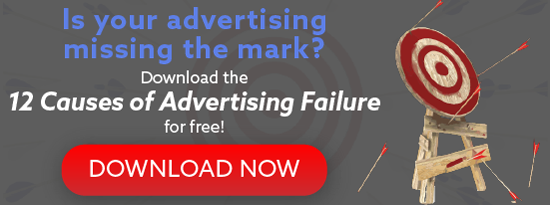Missouri Marketing Resource Blog

9 of 12 Causes of Advertising Failure: Overconfidence in Qualitative Targeting

Welcome back to our 12-part series about the causes of advertising failure. If you’ve missed failures #1-8 be sure to go back and read them, as they offer incredible insight, feedback, and discussion on advertising missteps for all business owners and marketers. We’ve arrived at advertising failure #9: overconfidence in qualitative targeting.
The importance of qualitative data has been grossly overestimated by many advertisers and marketing professionals. But what do you think is worse — saying the wrong thing, or reaching the wrong person? We can all agree that saying the wrong thing has killed far more ad campaigns than reaching the wrong audience. After all, it’s amazing how many people can become “the right people” when you are saying the right thing.
As we defined in our seventh advertising failure, obedience to unwritten rules, many marketers simply go with the flow, making their ads sound like everyone else’s. Do you want to communicate the same message as your competitors? No, definitely not. You want to find a way to be unique and stand out from the crowded market. In the same way, while you may be comfortable and overconfident in the quality of your targeting efforts, is it producing quantifiable results?
When crafting an advertisement, it’s absolutely crucial to make sure you’re saying the right thing. By doing so, you’ll need to understand your audience. If there were commandments in marketing, #1 would be “Know Thy Customer.” While it seems obvious, only 6% of companies understand customer needs extremely well. When having a compelling message, paired with a strong call-to-action and creative, the ROI possibilities are endless. Conversely, even if you’re reaching the right people, if you’re saying the wrong thing — who’s listening? Probably no one. Having an advertisement with the wrong message, targeted to your core group of consumers isn’t going to incite any sort of reaction, and it won’t resonate with anyone!
Your Message and The Buying Funnel
Shoppers are moving away from the purchasing funnel. They’re changing the way they research and buy your products, and if your marketing message hasn’t changed in response, it should. Remember — saying the right thing can depend entirely on where your audience is in the buying funnel. Moreover, without the ability to understand your buyer, you’re going to find it difficult to be where they are when they’re making decisions.
If your marketing has one goal, and one goal only, it should be to reach your audience at the moments that most influence their decisions. That’s why Amazon, more than a decade ago, began to offer targeted product recommendations to consumers already logged in (and ready to buy). In fact, Amazon says, 35% of its product sales result from those recommendations. It’s also why electronics companies make sure that consumers not only see their TV’s displayed in store, but also that those screens are displaying vivid, high-definition images.
As a marketer, you’re constantly seeking those moments, or touch points when your audience is open to influence. Many people depict this as a funnel — consumers start at the top of the funnel with numerous brands in mind, marketing efforts are then directed at them as they slowly weed out a few contenders and move through the funnel. At the end, they emerge with the one brand whose message most resonated with them, and the rest is history.
Today, however, the concept of the funnel fails to capture all the touch points and key buying factors that have resulted from the boom of product choices, and digital platforms, married with the growth of an increasingly discerning and well-informed buyer. As a result, a more sophisticated approach was created to help marketers navigate this new environment, which is less linear and more complicated than the funnel suggests. This new approach is called the buyer’s decision journey, or the buying funnel.
The decision-making process can be categorized into four phases:
-
Initial Consideration - Identify the need for their problem
-
Active Evaluation - Researching potential options
-
Closure - When consumers make a purchase
-
Post-purchase - When customers then get to experience the purchase and subsequently evaluate their decision.
At each phase, the consumer is in a different stage of their decision-making process and as such, your calls-to-action should reflect this. For example, someone just starting their search may be interested in reading more and signing up for updates, where someone further down the process might want to speak with someone to set up a consultation or get a quote.
Aligning your marketing with the buying funnel can be the difference between someone remaining a lead and converting them into a sale. To do this you need to develop a deep understanding of your audience, and how they make decisions. In some cases, you may need to change the direction of your marketing efforts to better help your consumers understand the brand as they actively evaluate it. Additionally, with the increasing complexity of the process — marketers need to find a quantitative way of measuring consumer attitudes, brand performance and the effectiveness of all advertising expenditures. This allows for evaluation after campaigns and at the end of each fiscal year to better prepare your team for future success.
By ignoring the funnel, and continuing to share poorly tailored messages to your consumers you’ll face two chief risks. First, you’ll waste a lot of money — and at a time when revenue growth is essential and funding possibly tight, advertising and other investments will be less effective because your audience isn’t getting the right information at the right time. Secondly, and possibly most importantly, you’ll seem out of touch and irrelevant. At a time when consumers are looking to learn more, you should be providing them with information, support and the full experience, not pushing your product on them. Consumers like to reach decisions themselves — help them do that by providing them with everything they need to make an educated decision. Don’t force them one way, as it’s likely to force them right out your door (or off your website).
Final Words on This Failure
Advertising is an investment, and yes, it can be a very expensive one. However, when done right, the benefit of advertising is clear — it provides results, and allows your brand to be seen and heard by interested consumers that otherwise wouldn’t know you exist. The main caveat, however is it has to be done right. If you’re throwing all your marketing dollars into a poorly thought-out campaign you’re wasting your money.
A failure to change the focus of your marketing efforts to match the evolving needs of your consumer undermines the core goals of reaching these shoppers at the moments that most influences their purchases. Remember to align your messages with the shift in consumer decisions to best resonate with their needs. Don’t look at this as a loss of power, but as an opportunity to be in the right place at the right time, providing your shoppers with all the information and assistance they’ll need in order to make the right decisions.
Make sure to check back next Monday when we highlight #10 in our 12-part series on advertising failures: event-driven marketing.
The 12 Causes of Advertising Failure courtesy of Roy H. Williams , author of The Wizard of Ads & Secret Formulas of the Wizard of Ads.

